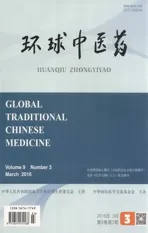《黄帝内经》心系疾病语篇译法的翻译比较初探
2016-04-11江楠吴伟
江楠 吴伟
510405 广州中医药大学第一附属医院心内科
·中医英译·
《黄帝内经》心系疾病语篇译法的翻译比较初探
江楠吴伟
510405广州中医药大学第一附属医院心内科
【摘要】《黄帝内经》为中医典籍的经典之作,书中有关心系疾病语篇的论述对后世医家产生了深远的影响。本文以李照国教授和伊尔扎·威斯女士两人的《内经》英译本为蓝本,进行翻译的比较研究,初步探讨英国语言学家韩礼德教授的衔接理论中“词项衔接”法在心系疾病语篇翻译中的应用,以期开辟中医药翻译领域中典籍语篇译法的新视角。
【关键词】黄帝内经;心系疾病;衔接理论;英译;语篇
英国著名语言学家韩礼德教授(M.A.K Halliday)(1925- )是英语系统功能语言学的奠基人,他所创立的衔接理论对语言学的教与学产生了深远的影响。《黄帝内经》奠定了中医学理论体系的基础,为中医典籍的经典之作。古今中外,很多翻译家纷纷对其进行过深入的研究和探索,留下了众多的译本。
本文以李照国教授和伊尔扎·威斯女士两人的《内经》英译本为蓝本,进行翻译的比较研究,初步探讨韩礼德教授的衔接理论中“词项衔接”法在心系疾病语篇翻译中的应用,以期为中医药翻译领域中典籍语篇的译法开辟新的研究视角。
1系统功能语言学理论
韩礼德(M.A.K Halliday)(1925- )是英国著名的语言学家、语言学教授。他师从伦敦学派,在后天的研究中不断吸收其他学派之所长,在许多语言理论和应用研究领域中建树众多。他提出了著名的“系统功能语言学”,对语言学的教与学产生了深远的影响。
系统功能学理论强调从功能角度来看待语言,“任何一个篇章都可以被赋予一个特定的功能,即它完全是,至少主要是,为了实现某个交际目的”[1]。该理论认为,语言系统有三大功能(如图1):概念功能(ideational metafunction)、人际功能(interpersonal metafunction)和篇章功能(textual metafunction)。“篇章功能”是一个语义概念,其长度可以从一个词到一篇文章,它既使篇章内部衔接,也使它跟外部情景语境衔接。篇章的功能可以划分为:结构性功能和非结构性功能。前者主要由主位结构和信息结构组成,而后者主要体现为衔接。

图1 语言系统的三大功能
2语篇衔接理论中的“词项衔接”法
衔接可以分为两种类型:一类是语法衔接(grammatical cohesion),另一类是词项衔接(lexical cohesion)。词项衔接指篇章内词汇的选择对组织结构所起的作用(Lexical cohesion refers to the role played by the selection of vocabulary in organizing relations within a text[2]),包括相同、相似、相近和相反,它表达一种意义关系。
词项衔接分为两类(如图2):复现(reiteration)和词汇搭配(collocation)。复现表示衔接纽带一端出现一个项目后,其另一端由相同、更概括、同义等词汇占据的现象,如:重复(repetition)、同义词(synonymy)、反义词(antonymy)、上下义词(hyponymy)、局部-整体关系(meronymy)等[3]。词汇搭配表示通常出现在同一个语义场的项目同现的现象(Collocation …… involves a pair of lexical items that are associated with each other in the language in some way[4])。

图2 衔接关系——词项衔接
3“词项衔接”法在《黄帝内经》心系疾病语篇翻译中的应用
《黄帝内经》奠定了中医学理论体系的基础,为中医典籍的经典之作。古今中外很多翻译学家对其进行过深入的研究和探索,留下了众多的译本。本文将李照国教授《内经》全译本(以下简称“李译”)和美国约翰·霍普金斯大学医学史研究所伊尔扎·威斯女士(Ilza Veith)《内经》英译本(以下简称“威译”)进行对比翻译研究,探讨“词项衔接”法在心系疾病语篇翻译中的应用。
例1病在心,愈在长夏,长夏不愈,甚于冬,冬不死,持于春,起于夏,禁温食热衣。心病者,愈在戊已,戊已不愈,加于壬癸,壬癸不死,持于甲乙,起于丙丁。心病者,日中慧,夜半甚,平旦静。心欲耎,急食咸以耎之,用咸补之,甘泻之。(《素问·脏气法时论篇第二十二》)
李译[5]:Disease of the heart heals in late summer. If failing to heal in late summer, it will be worsened in winter. If it does not lead to death in winter, [it will be] stable in spring and improved in summer. [It is important] to avoid hot-natured food and warm clothes. Heart disease heals in [the days of] Wu and Ji. If failing to heal in [the days of] Wu and Ji, it will be worsened in the days of Ren and Gui. If it does not lead to death in the days of Ren and Gui, it becomes stable in [the days of] Jia and Yi and improved in [the days of] Bing and Ding. Heart disease gets improved in the noon, worsened in the midnight and calms down in the morning. [Since] the heart needs to be softened, [the treatment of heart disease] requires immediate use of salty flavor to soften and supplement and sweet flavor to purge.
威译[6]:When the disease is located within the heart it should improve during the long Summer. If it does not improve during the long Summer, it becomes graver in Winter. If in Winter death does not follow, it can be warded off in Spring; but the disease will arise again in Summer. Then one should avoid eating hot food and wearing clothes that produce heat.
Those who suffer from a disease of the heart should be cured during the period of the celestial stems wu chi. When the improvement has not taken place during the period of wu chi, it will be the same in the period of jên kuei; and when death does not strike during the period of the celestial stems jên kuei, it can be warded off during the period of the celestial stems chia i. But the disease arises again during the period of the celestial stems ping ting.
Those who suffer from a sick heart are animated and quick-witted at noon, around midnight their spirits are heightened, and in the early morning they are peaceful and quiet. A (sick) heart has the tendency to soften and to weaken. Then one should quickly eat salty food to make the heart pliable. One uses salty food in connection with the heart in order to supplement and to strengthen it, and one uses sweet food in order to drain and to dispel.
李译文开头disease和heal,后面的hot-natured food 和 warm clothes分别构成两组词项衔接,“疾病”和“治愈”、“温食”和“热衣”往往成对出现,构成搭配关系。同一句中,…heals in late summer和…heal in late summer构成原词重复的词项衔接手法。… worsened in winter 中的worsened和前句heal构成一组反义词衔接,in winter和下句…lead to death in winter 也构成一组原词重复的词项衔接。这两组原词重复构成的词项衔接是“愈在长夏,长夏不愈,甚于冬,冬不死…”的译文,原文使用了顶真的修辞手法,将其处理为词项衔接的译法,既保留了原文的修辞特色,又起到前后呼应的作用。与此相同,“愈在戊已,戊已不愈,加于壬癸,壬癸不死…”也采用了相同的译法,使语句之间形成环环相扣、回环往复的音韵之美if failing to heal…、if failing to heal in the days of…中if failing to do是原词重复的词项衔接。Heart disease gets improved…和Since the heart…全篇开始处disease of the heart 构成“心病”一词的原词重复,变换了词语的形式,有效地避免了译文的单调。结尾句“补之”和“泻之”构成一组反义词的词项衔接,译为to supplement和to purge,二者构成结构相同、含义相反的结构,形式整齐又不失译文的古韵。
威译文中也多次使用词项衔接,以求内容整体上的完整连贯。第一段中的improve和graver,warded off和avoid是两组反义词衔接,分别对应原文“(痊)愈”和“甚(加重之意)”、“持(病情稳定)”和“起(好转)”。第二段结尾句中arise呼应第一段中的warded off,也构成反义衔接,在深层次上使两个语段的语义相互联系,保持语义在读者心目中的完整性和有效性。下文中take place和strike为同义词衔接。第三段结尾处的to supplement and to strengthen和 to drain and to dispel翻译“补之”“泻之”,与李译本有异曲同工之妙。在搭配词汇衔接方面,文中也出现了多处,如hot food and wearing clothes,animated and quick-witted以及peaceful and quiet。此外,也使用了很多重复词汇衔接,如improve during the long Summer,the disease,during the period of等。
例2心病者,胸中痛,胁支满,胁下痛,膺背肩甲间痛,两臂内痛,虚则胸腹大,胁下与腰相引而痛。取其经,少阴太阳,舌下血者。其变病,刺郄中血者。(《素问·脏气法时论第二十二》)
李译[5]:Heart disease is characterized by pain in the chest, distending hypochondriac fullness, hypochondriac pain, pain involving the chest, back and scapula as well as pain of the medial sides of the arms. Xu (Deficiency) [of the heart] leads to distension of the chest and abdomen as well as referred pain in the hypochondrium and waist. [To treat this disease, the Acupoints located on] the Shaoyin and Taiyang [can be selected] and the sublingual [vessel is pricked] to let out blood. [If] the disease has changed, [it can be treated by] pricking Xizhong to let out blood.
威译[6]:Sickness of the heart causes pains within the breast extending over the branches of the ribs. It causes pains below the ribs (flanks) and upon the breast. The top of the shoulders and the spaces between the fingernails hurt, and there are pains within both arms. And the entire region extending from the ribs to the flanks is affected and full of pain.
(In order to cure the heart) one should select from the vascular system those arteries which are controlled by the lesser Yin and the great Yang, and the blood which is contained underneath the root of the tongue. Their changes indicate the diseases. One must pierce (with acupuncture) the spot which causes the disorder in order to reach the blood which is contained therein.
李译文开篇处提到…characterized by pain in the chest,即“(胸中)痛”,此后原文多次提及疼痛,如“(胁下)痛”“(膺背肩甲间)痛” “(两臂内)痛”“(胁下与腰)相引而痛”,在译文中体现为hypochondriac pain, pain involving the chest,pain of the medial sides of the arms,referred pain in the hypochondrium and waist,各处pain在此为原词重复的词项衔接。其后To treat this disease 和if the disease has changed都是呼应开篇提及的主题heart disease,故也为原词重复的词项衔接。在中医理论中,心与小肠相表里,那么Shaoyin and Taiyang中Shaoyin(手少阴心经)和Taiyang(手太阳小肠经)为搭配衔接。pricking Xizhong to let out blood里pricking(刺)和 let out blood(放血)是中医的治法——“刺络放血”,故此处两次也构成搭配衔接关系。To treat this disease和 it can be treated by 中treated 为treat的被动语态形式,二者构成变体重复的词项衔接。同理,sublingual vessel is pricked和pricking Xizhong中pricked和pricking都是动词prick的分词形式,亦为变体重复的词项衔接。
威译文中,第二句below the ribs and upon the breast 中ribs和breast呼应第一句中的the branches of the ribs, within the breast,为原词重复的词项衔接。Sickness of the heart causes pains和其后的 it causes pains, there are pains within both arms,…is affected and full of pain中的pain(s)构成原词重复的词项衔接。the entire region中entire region是其后from the ribs to the flanks的上义词,二者构成上下义词的词项衔接关系。their changes indicate…中changes 指上文提到的“胸腹胀大,胁下与腰背部牵引作痛等症状”,是上下义词的词项衔接。Their changes indicate the diseases中the diseases和the spot which causes the disorder中the disorder都是指“此病”,为同义词的词项衔接。
4结语
韩礼德教授主张“衔接理论是非结构性成分在跨句际意义联系上的体现”[7],这种理论在译文的布局谋篇上具有十分重要的意义。笔者将其运用于中医典籍《黄帝内经》心系疾病的语篇分析中,能够从深层次上更客观地剖析译本所采取的翻译策略,掌握构建语篇内容的语言。
在今后的翻译实践中,译者要有意识地运用词项衔接的翻译策略,加强译文语篇内在的逻辑联系和语义联系,将重“意合”的古文原文巧妙地转化成层层铺展、环环相扣的“形合”语篇,在带给读者以美的享受的同时,也为更好地推动中医翻译的发展、促进中医对外交流、传播中医文化提供了一种全新的途径。
参考文献
[1]Copeland J and Davis P.The Seventh LACUS Forum 1980 [M]. Columbia, S.C.: Hornbeam Press,1981:236.
[2]Baker M. In Other Words: A Coursebook on Translation [M].Beijing:Foreign Language Teaching and Research Press,2000:190,202-203.
[3]胡壮麟,朱永生,张德禄,等.系统功能语法概论[M].北京: 北京大学出版社,2008:23-47.
[4]Halliday, M.A.K.,Hasan, R. Cohesion in English [M].London and New York:Longman, 1976:9-143.
[5]李照国,刘希茹.汉英对照·黄帝内经素问[M].西安:世界图书出版公司,2005:301,305-307.
[6]Veith I. The Yellow Emperor’s Classic of Internal Medicine[M]. U.S.A.: University of California Press,1972:200-201,204.
[7]张娟,田翠芸.从语篇衔接看汉英语篇的翻译处理[J].河北联合大学学报(社会科学版),2013,13(3):110-112.
(本文编辑: 蒲晓田)
(上接本期第315页)
[1]叶芳,袁野,陆华,等.花红胶囊及花红颗粒治疗慢性盆腔炎(湿热郁结证)的临床观察[J].西部中医药,2013,26 (2):4-7.
[2]王萍.中西医结合治疗慢性盆腔炎临床观察[J]. 中国实用医刊,2012,39(12):70-71.
[3]乐杰.妇产科学[M]. 6版. 北京:人民卫生出版社,2004:274.
[4]陈小平,陈靓芬,陶莉莉. 中药联合腹腔镜对盆腔炎性不孕患者肿瘤坏死因子α的影响[J]. 云南中医中药杂志,2013,34(6):16-20.
[5]高妍,卢东方.中药灌肠与微波治疗慢性盆腔炎疗效比较[J].河北中医药学报,2013,28 (2):21-22.
[6]董丽君.妇科千金胶囊与抗生素联合使用治疗慢性盆腔炎35例分析[J]. 中外医学研究,2010,8(9):104.
[7]吴小娟. 中药联合腹腔镜治疗盆腔炎性不孕效果分析[J]. 深圳中西医结合杂志, 2015, 25(9):48-50.
[8]刘洪玲.银翘红酱解毒汤联合西药治疗急性盆腔炎38例[J]. 吉林中医药,2006,26(7):34.
(本文编辑: 韩虹娟)
(收稿日期:2015-05-19) 2015-11-19)
【中图分类号】H059
【文献标识码】A
doi:10.3969/j.issn.1674-1749.2016.03.027
作者简介:江楠(1987- ),女,博士。研究方向:中医药防治心血管病、中医英语翻译。E-mail:roupangguier@sohu.com
